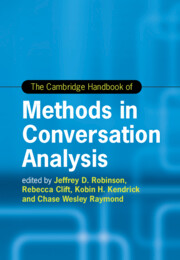Book contents
- Frontmatter
- Contents
- List of Tables
- List of Contributors
- Part I Introduction
- Part II Points of Departure
- Part III Collections
- Part IV Evidence
- Part V Avenues into Action
- 18 Single-Case Analysis
- 19 Ethnomethodology, Conversation Analysis, and the Study of Interaction in Everyday Life
- 20 Analyzing Categorial Phenomena in Talk-in-Interaction
- 21 Where the Action Is: Positioning Matters in Interaction
- 22 Analyzing Particles
- 23 Analyzing Grammar in Social Interaction
- 24 Listening to Talk-in-Interaction: Ways of Observing Speech
- 25 Multimodality in Conversation Analysis
- 26 System-Oriented Analysis: Moving from Singular Practices to Organizations of Practice
- 27 Comparing across Languages and Cultures
- 28 Methodological Considerations When Using Conversation Analysis to Investigate Institutional Interaction
- 29 Methods for ‘Applying’ Conversation Analysis
- 30 Using Conversation-Analytic Research Methods in the Study of Atypical Populations
- Part VI Situating and Reporting Findings
- Part VII Looking Forward
- Appendix I Jeffersonian Transcription Conventions
- Appendix II Multimodal Transcription Conventions
- Index
25 - Multimodality in Conversation Analysis
from Part V - Avenues into Action
Published online by Cambridge University Press: 06 December 2024
- Frontmatter
- Contents
- List of Tables
- List of Contributors
- Part I Introduction
- Part II Points of Departure
- Part III Collections
- Part IV Evidence
- Part V Avenues into Action
- 18 Single-Case Analysis
- 19 Ethnomethodology, Conversation Analysis, and the Study of Interaction in Everyday Life
- 20 Analyzing Categorial Phenomena in Talk-in-Interaction
- 21 Where the Action Is: Positioning Matters in Interaction
- 22 Analyzing Particles
- 23 Analyzing Grammar in Social Interaction
- 24 Listening to Talk-in-Interaction: Ways of Observing Speech
- 25 Multimodality in Conversation Analysis
- 26 System-Oriented Analysis: Moving from Singular Practices to Organizations of Practice
- 27 Comparing across Languages and Cultures
- 28 Methodological Considerations When Using Conversation Analysis to Investigate Institutional Interaction
- 29 Methods for ‘Applying’ Conversation Analysis
- 30 Using Conversation-Analytic Research Methods in the Study of Atypical Populations
- Part VI Situating and Reporting Findings
- Part VII Looking Forward
- Appendix I Jeffersonian Transcription Conventions
- Appendix II Multimodal Transcription Conventions
- Index
Summary
This chapter provides for principles, guidance, and illustrations about the way multimodality is conceptualized and operationalized within Conversation Analysis. It discusses the foundations of CA multimodal studies and shows how multimodal analysis can be conducted, on the basis of several empirical exemplary cases. The introduction of this chapter focuses on the conceptualization and definition of multimodality, and their methodological consequences. The subsequent sections guide readers through empirical analyses of various phenomena that have progressively expanded multimodal analysis, beginning with apparently simple co-speech gestures, and showing how they actually involve the entire body, continuing with the temporality of multiactivity, the spatiality of mobile activities, and the materiality of multisensoriality. These phenomena constitute exemplary areas of study in which the body features in a crucial way, and in which the interplay of linguistic and embodied resources provide for the accountability and intersubjectivity of the ongoing action in interaction.
- Type
- Chapter
- Information
- The Cambridge Handbook of Methods in Conversation Analysis , pp. 700 - 742Publisher: Cambridge University PressPrint publication year: 2024

